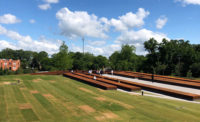Buffalo, N.Y., and Fort Erie, Ontario, Canada
Mulvey+Banani International
The Peace Bridge connecting Buffalo to Fort Erie, Ontario, commemorates cordial relations between Canada and the United States. Yet until last January, the high-pressure sodium lamps illuminating the hulking deck bridge exemplified hostility. “They were causing glare and not really lighting the structure at all,” says Mulvey+Banani senior lighting designer Paul Boken.
So when the joint American-Canadian Peace Bridge Authority received a $1 million grant to upgrade systems, it determined the old equipment should go, and commissioned Mulvey+Banani to develop a new lighting concept in March 2008.
Completed in May 2009, the firm’s design underscores the beauty of the bridge’s lacelike trusses and its overall symbolism. “A bridge represents movement, so we didn’t want to create a static image,” Boken explains. Now, at the top of the hour, a light system manager (LSM) randomly chooses from approximately 50 light sequences, and for 10 minutes it washes the bridge in duotone combinations or pulses of illumination. For the remaining time, the LSM chooses a single static arrangement from a collection that ranges from pastel pairings to a simple whitewash to special holiday and Buffalo Sabres color schemes.
According to Boken, there are 695 LED luminaires installed on the 5,800-foot-long bridge. To integrate them, the designer used a holistic Color Kinetics system with software that maps and engages the LEDs in clusters, rather than individually, for numerous lighting sequences. Its DMX (Digital Multiplexing) signals then travel from the Fort Erie—based server on fiber-optic cable spliced to fiber-optic infrastructure installed underneath the bridge. At six junctions evenly spaced above bridge piers, the fiber-optics convert to ethernet wiring. This controls the LEDs, which are not compatible with fiber-optic technology, inconspicuously tucked underneath structural beams on Unistrut arms — and within reach of a suspended catwalk for easy installation and maintenance.
Daily light shows entertain residents on both sides of the Niagara River as well as anyone driving across it. To let drivers enjoy these colorful displays without distraction, the design team mounted canted LED luminaires on a Parker truss 6 feet above the height of a typical truck cab and shielded each fixture with a honeycomb louver. “We weren’t so concerned about light reflecting on the beams,” notes Boken, “but rather showing a source that could be mistaken for a stoplight.” In a similar spirit of safety, new full-cut-off, metal-halide lamps increase visibility for motorists and security cameras. Yet, despite its use of state-of-the-art illumination combining LED and metal- halide sources, Mulvey+Banani’s lighting design for the Peace Bridge has reduced its average energy consumption by 50 percent.






Post a comment to this article
Report Abusive Comment